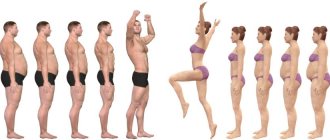Body mass index
Quetelet index (body mass index, BMI ) is a more progressive option. The body mass index indicator was developed by the Belgian sociologist and statistician Adolphe Quetelet in 1869.
BMI = weight (kg) / [height (m)]2 For example, a person’s weight = 60 kg, height = 170 cm. Therefore, the body mass index in this case is equal to: BMI = 60: (1.70 × 1.70) = 20.7 The results are compared with the tabular data.
In accordance with WHO recommendations, the following interpretation of BMI indicators has been developed:
| Body mass index | Correspondence between a person's mass and his height |
| 16 or less | Severe underweight |
| 16—18,5 | Insufficient (deficit) body weight |
| 18,5—24,99 | Norm |
| 25—30 | Excess body weight (pre-obesity) |
| 30—35 | Obesity of the first degree |
| 35—40 | Obesity of the second degree |
| 40 or more | Obesity of the third degree (morbid) |
The body mass index should be used with caution, solely for indicative assessment - for example, an attempt to evaluate the physique of professional athletes with its help may give an incorrect result (a high index value in this case is explained by developed muscles).
Broca's formula
Ideal weight for men = (height in centimeters – 100) · 1.15. Ideal weight for women = (height in centimeters – 110) · 1.15.
Example: Ideal weight for a woman 170 cm tall = (170 – 110) · 1.15 = 69 kg.
Broca-Brugsch formula
The previous formula was modified taking into account body type and non-standard height.
So, hypersthenics add 10% to the form, and asthenics subtract 10%. As for height, now it is proposed to calculate as follows (X is height in centimeters): less than 165 cm: X - 100 165-175 cm: X - 105 more than 175 cm: X - 110.
Already in this form the result is more optimal. So, a girl with a normosthenic physique and a height of 168 cm should weigh: 168-105 = 63 kg.
How to determine your body type?
The easiest way to determine your body type is to measure your wrist at the narrowest point.
If the result is in women:
- – less than 14 cm – you have an asthenic physique;
- – from 14 to 18 cm – you are normosthenic;
- – more than 18 cm – you have a hypersthenic physique.
Men have slightly different numbers:
- – less than 17 cm – this is an asthenic type;
- – from 17 to 20 cm – normosthenic type;
- – more than 20 cm – hypersthenic type.
There is another way to find out your body type - using the ratio of height and leg length.
Leg length is measured from the tuberosity of the femur (opposite the hip joint) to the floor. Their ideal length should be within the following limits:
- – asthenic type: legs are 2-4 cm longer than half the height;
- – normosthenic type: legs are 4-6 cm longer than half the height;
- – hypersthenic type: legs are 6-9 cm longer than half the height.
Other indices for determining normal weight
Breitman index. Normal body weight is calculated using the formula - height [cm] • 0.7 - 50 kg.
Bernhard index. Ideal body weight is calculated using the formula - height [cm] • chest circumference [cm] / 240.
Davenport Index . A person's mass [g] divided by height [cm] squared. An increase above 3.0 indicates the presence of obesity (obviously, this is the same BMI, only divided by 10).
Oder index. Normal body weight is equal to the distance from the crown to the symphysis [cm] • 2 - 100.
Noorden index. Normal weight equals height [cm] • 420/1000.
Tatonya index . Normal body weight = height − (100 + (height − 100) / 20)
In clinical practice, body mass index is most often used to assess body weight.
We must not forget that body weight also depends on a person’s age. The following chart will also help you determine your weight category.
Weight table for women
Many years ago, there was a formula for an ideal female weight, which was calculated as follows: 110 was subtracted from height (in cm) and the desired weight was obtained. But such a simplified pattern only worked well for fitness models, but women with pronounced hips and breasts could not fit into this category. Therefore, they began to take into account body type.
According to the calculations of the French anthropologist Paul Broca, to calculate the ideal female weight using the table above. However, over the years, the body consumes less and less energy, and therefore metabolic processes slow down, and fat increases. This leads to gaining extra pounds.
© Depositphotos
Not everyone can be assigned a specific body type. After all, a person may have a transitional option between, say, thin and average. However, the indicator of normal weight will not differ much here, and if you have doubts about extra pounds, you should consult a nutritionist.
© Depositphotos
Seeing a doctor also makes sense when the number on the scale matches the ideal weight in the table, but the reflection in the mirror is not pleasing. You may have to take tests for hormones and sugar. Due to the characteristics of the body, the ideal weight indicator can differ in any direction.
We also note that for teenage girls under the age of 18, determining the ideal weight is impossible in principle, because their body is only growing and taking shape. Also, the table indicators will differ significantly among training athletes whose body fat percentage is lower than usual.
© Depositphotos
Some people carefully monitor their body and calculate ideal indicators, while others trust their inner feelings, the mirror and the words of their loved one more. Well, everyone has the right to treat their own body as they see fit. We agree that the correct weight is the one with which the woman herself is comfortable.
Weight table of academician A.A. Pokrovsky
You can also use a table developed by the Soviet biochemist, academician A.A. to determine normal body weight, taking into account gender, age and body constitution. Pokrovsky Normal body weight at the age of 25-30 years (according to A. A. Pokrovsky)
| Height cm | Men, kg | Height cm | Women, kg | ||||
| Narrow chest | Normal rib cage | Wide chest | Narrow chest | Normal rib cage | Wide chest | ||
| 155.0 | 49.30 | 56.00 | 62.20 | 152.5 | 47.80 | 54.00 | 59.00 |
| 157.5 | 51.70 | 58.00 | 64.00 | 155.0 | 49.20 | 55.20 | 61.60 |
| 160.0 | 53.50 | 60.00 | 66.00 | 157.5 | 50.80 | 57.00 | 63.10 |
| 165.0 | 55.50 | 61.70 | 68.00 | 160.0 | 52.10 | 58.50 | 64.80 |
| 162.5 | 57.10 | 63.50 | 69.50 | 162.5 | 53.80 | 60.10 | 66.30 |
| 167.5 | 59.30 | 65.80 | 71.80 | 165.0 | 55.30 | 61.80 | 67.80 |
| 170.0 | 60,50 | 67.80 | 73.80 | 167.5 | 56.60 | 63.00 | 69.00 |
| 172.5 | 63.30 | 69.70 | 76.80 | 170.0 | 57.80 | 64.00 | 70.00 |
| 175.0 | 65.30 | 71.70 | 77.80 | 172.5 | 59.00 | 65.20 | 71.20 |
| 180.0 | 68.90 | 75.20 | 81.20 | 175.0 | 60.30 | 66.50 | 72.50 |
| 182.5 | 70.90 | 77.20 | 83.60 | 177.5 | 61.50 | 67.70 | 74.90 |
| 185.0 | 72.80 | 79.20 | 85.20 | 180.0 | 62.70 | 68.90 | 73.70 |
Note. At the age of over 30 years, it is permissible to increase weight compared to the table for men by 2.5 - 6 kg, for women - by 2.5 - 5 kg.
Egorov-Levitsky table
The table shows the maximum weight for this height.
Maximum permissible body weight
| Height, cm | 20–29 years old | 30–39 years old | 40–49 years old | 50–59 years old | 60–69 years old | |||||
| husband. | wives | husband. | wives | husband. | wives | husband. | wives | husband. | wives | |
| 148 | 50,8 | 48,4 | 55 | 52,3 | 56,6 | 54,7 | 56 | 53,2 | 53,9 | 52,2 |
| 150 | 51,3 | 48,9 | 56,7 | 53,9 | 58,1 | 56,5 | 58 | 55,7 | 57,3 | 54,8 |
| 152 | 51,3 | 51 | 58,7 | 55 | 61,5 | 59,5 | 61,1 | 57,6 | 60,3 | 55,9 |
| 154 | 55,3 | 53 | 61,6 | 59,1 | 64,5 | 62,4 | 63,8 | 60,2 | 61,9 | 59 |
| 156 | 58,5 | 55,8 | 64,4 | 61,5 | 67,3 | 66 | 65,8 | 62,4 | 63,7 | 60,9 |
| 158 | 61,2 | 58,1 | 67,3 | 64,1 | 70,4 | 67,9 | 68 | 64,5 | 67 | 62,4 |
| 160 | 62,9 | 59,8 | 69,2 | 65,8 | 72,3 | 69,9 | 69,7 | 65,8 | 68,2 | 64,6 |
| 162 | 64,6 | 61,6 | 71 | 68,5 | 74,4 | 72,7 | 72,7 | 68,7 | 69,1 | 66,5 |
| 164 | 67,3 | 63,6 | 73,9 | 70,8 | 77,2 | 74 | 75,6 | 72 | 72,2 | 70 |
| 166 | 68,8 | 65,2 | 74,5 | 71,8 | 78 | 76,5 | 76,3 | 73,8 | 74,3 | 71,3 |
| 168 | 70,8 | 68,5 | 76,3 | 73,7 | 79,6 | 78,2 | 77,9 | 74,8 | 76 | 73,3 |
| 170 | 72,7 | 69,2 | 77,7 | 75,8 | 81 | 79,8 | 79,6 | 76,8 | 76,9 | 75 |
| 172 | 74,1 | 72,8 | 79,3 | 77 | 82,8 | 81,7 | 81,1 | 77,7 | 78,3 | 76,3 |
| 174 | 77,5 | 74,3 | 80,8 | 79 | 84,4 | 83,7 | 83 | 79,4 | 79,3 | 78 |
| 176 | 80,8 | 76,8 | 83,3 | 79,9 | 86 | 84,6 | 84,1 | 80,5 | 81,9 | 79,1 |
| 178 | 83 | 78,2 | 85,6 | 82,4 | 88 | 86,1 | 86,5 | 82,4 | 82,8 | 80,9 |
| 180 | 85,1 | 80,9 | 88 | 83,9 | 89,9 | 88,1 | 87,5 | 84,1 | 84,4 | 81,6 |
| 182 | 87,2 | 83,3 | 90,6 | 87,7 | 91,4 | 89,3 | 89,5 | 86,5 | 85,4 | 82,9 |
| 184 | 89,1 | 85,5 | 92 | 89,4 | 92,9 | 90,9 | 91,6 | 87,4 | 88 | 85,9 |
| 186 | 93,1 | 89,2 | 95 | 91 | 96,6 | 92,9 | 92,8 | 89,6 | 89 | 87,3 |
| 188 | 95,8 | 91,8 | 97 | 94,4 | 98 | 95,8 | 95 | 91,5 | 91,5 | 88,8 |
| 190 | 97,1 | 92,3 | 99,5 | 95,6 | 100,7 | 97,4 | 99,4 | 95,6 | 94,8 | 92,9 |
Many consider this table to be the most comprehensive and balanced approach to determining the presence of excess weight.
Features of determining normal weight for women
Using the Quetelet index Ideal body weight is associated not only with a person’s body type, but also with his age. One of the calculation options is the Quetelet index. So, for example, for girls 15-18 years old it is equal to the following values: for asthenics - 315 g, normosthenics - 325 g, hypersthenics - 355 g for every 1 cm of height. For girls 19-25 years old, the Quetelet index will be equal to, respectively: 325 g, 345 g and 370 g. For women 26-39 years old – 335 g, 360 g and 380 g per 1 cm of height. In addition, for those girls and women whose height is below 1m 60 cm, the weight should be 10-15% less. This is especially necessary for girls under 20 years old.
Lorenz formula Ideal weight of a woman = (height in centimeters – 100) – (height in centimeters – 150) / 2. Or a simplified version: X/2-25, where X is height in centimeters. Example: Ideal weight for a woman 165 cm tall = (165 – 100) – (165 – 150) / 2 = 65 – 15/2 = 57.5. The obvious simplicity of the method has both a positive and a negative side. The Lorenz formula does not differentiate people by type (asthenic, normosthenic, hypersthenic), and does not take into account age and the presence of physical activity. The result can be considered quite average. Please note that this formula was developed only for women and is in no way suitable for the stronger sex. At first glance, it is too demanding on weight compared to the improved Brocca formula and rather indicates exactly the ideal weight when you were eighteen years old. However, it is completely consistent with the body mass index (BMI), so it is quite possible to use it. If you are upset by the proposed numbers, then just forget about it and use another formula. By the way, it still won’t suit women taller than 175 cm
Features of the figure The percentage of fat in a woman's body is of great importance. Trying to create an ideal body, like the professionals, with 5% body fat is unrealistic, since these values are achieved with the help of special diets and special pharmacology. But 10% is ideal. If we compare two girls with the same weight of 60 kg and different percentages of body fat - 10 and 20%, then the first will have 6 kg more muscle tissue than the second. The appearance of both beauties will be strikingly different! If girls with an hourglass figure just need to lose weight so that their ideal body proportions become visible, then “pears” need to focus on strength training in order to slightly build muscle on their narrow shoulders, and “apples” need to give preference to aerobic exercise and exercises for lower body.
Psychologists strongly advise ignoring BMI and other standardized indices. If your reflection makes you happy, but the test showed a slight deviation from the norm, do not be upset about it. It is difficult not to notice excess weight, and a harmonious figure does not require additional confirmation. Use your own common sense when critically assessing appearance. And don't put too much emphasis on dry standard numbers, which are very relative.
Ideal weight calculator using Broca's formula
Weight calculator provided by the site calcus.ru
Ideal weight is a rather relative concept. From a medical point of view, this term refers to the body weight at which vital processes proceed normally. At the same time, the body does not suffer from nutritional deficiencies, and the volume of adipose tissue is not so large as to provoke metabolic disorders.
One of the most universal formulas for calculating ideal weight is the Broca index. It takes into account several parameters at once:
- Height;
- Body type;
- Age.
The constitutional type is determined using the Solovyov index. To do this, measure the circumference of your wrist with a measuring tape. This indicator reflects bone thickness, which directly affects body weight. The measurement results are interpreted as follows:
- <15 cm in women or <18 cm in men – asthenic (ectomorphic) physique. These are thin people with thin bones and little muscle mass. As a rule, they have a faster metabolism, so fat deposits are small.
- 15 – 17 cm in women or 18 – 20 cm in men – normosthenic (mesomorphic) type. This constitutional option is closest to the athletic one. Normosthenics have well-developed muscles, but adipose tissue also accumulates quite easily, which, with a sedentary lifestyle, leads to excess weight gain.
- > 17 cm in women or > 20 cm in men – hypersthenic (endomorphic) physique. In hypersthenics, metabolic processes proceed more slowly, which means that fats are burned worse. As a rule, these are people of short stature, with broad bones, and a tendency to be overweight.
Having determined the Solovyov index and measured your height, you can calculate your ideal weight using Brock’s formula:
- If height is less than 165 cm: weight (kg) = (height (cm) – 100) ± coefficient;
- If height is from 165 to 175 cm: weight (kg) = (height (cm) – 105) ± coefficient;
- If height is above 175 cm: weight (kg) = (height (cm) – 100) ± coefficient.
The coefficient depends on the constitutional type and age of the person. Persons 20-30 years old should subtract 11% from the result, and after 50 years old, add an additional 6%. Asthenics subtract 10% from the final figure, and hypersthenics add 10%. Normosthenics aged 30–50 years do not need to add or subtract coefficients.
To avoid complex calculations, you can use an online ideal weight calculator. To do this, you need to enter your height and wrist circumference in centimeters in the appropriate fields, select your age and gender from the list and click on the “Calculate” button.
As a result, you will receive a digital indicator of your ideal weight. However, remember that this is an average value and small deviations from the norm in one direction or another are quite acceptable.











